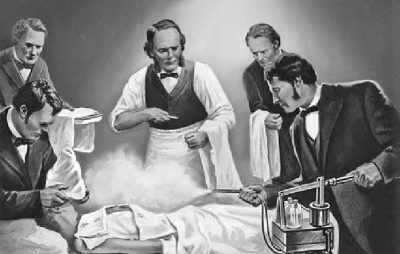
After taking an arts course at University College, London, he enrolled in the faculty of medical science in October 1848. A brilliant student, he was graduated a bachelor of medicine with honours in 1852; in the same year he became a fellow of the Royal College of Surgeons and house surgeon at University College Hospital. A visit to Edinburgh in the fall of 1853 led to Lister’s appointment as assistant to James Syme, the greatest surgical teacher of his day, and in October 1856 he was appointed surgeon to the Edinburgh Royal Infirmary. In April he had married Syme’s eldest daughter. Lister, a deeply religious man, joined the Scottish Episcopal Church. The marriage, although childless, was a happy one, his wife entering fully into Lister’s professional life.
When three years later the Regius Professorship of Surgery at Glasgow University fell vacant, Lister was elected from seven applicants. In August 1861 he was appointed surgeon to the Glasgow Royal Infirmary, where he was in charge of wards in the new surgical block. The managers hoped that hospital disease (now known as operative sepsis—infection of the blood by disease-producing microorganisms) would be greatly decreased in their new building. The hope proved vain, however. Lister reported that, in his Male Accident Ward, between 45 and 50 percent of his amputation cases died from sepsis between 1861 and 1865.
In this ward Lister began his experiments with antisepsis. Much of his earlier published work had dealt with the mechanism of coagulation of the blood and role of the blood vessels in the first stages of inflammation. Both researches depended upon the microscope and were directly connected with the healing of wounds. Lister had already tried out methods to encourage clean healing and had formed theories to account for the prevalence of sepsis. Discarding the popular concept of miasma—direct infection by bad air—he postulated that sepsis might be caused by a pollen-like dust. There is no evidence that he believed this dust to be living matter, but he had come close to the truth. It is therefore all the more surprising that he became acquainted with the work of the bacteriologist Louis Pasteur only in 1865.
Pasteur had arrived at his theory that microorganisms cause fermentation and disease by experiments on fermentation and putrefaction. Lister’s education and his familiarity with the microscope, the process of fermentation, and the natural phenomena of inflammation and coagulation of the blood impelled him to accept Pasteur’s theory as the full revelation of a half-suspected truth. At the start he believed the germs were carried solely by the air. This incorrect opinion proved useful, for it obliged him to adopt the only feasible method of surgically clean treatment. In his attempt to interpose an antiseptic barrier between the wound and the air, he protected the site of operation from infection by the surgeon’s hands and instruments. He found an effective antiseptic in carbolic acid, which had already been used as a means of cleansing foul-smelling sewers and had been empirically advised as a wound dressing in 1863. Lister first successfully used his new method on August 12, 1865; in March 1867 he published a series of cases. The results were dramatic. Between 1865 and 1869, surgical mortality fell from 45 to 15 percent in his Male Accident Ward.
In 1869, Lister succeeded Syme in the chair of Clinical Surgery at Edinburgh. There followed the seven happiest years of his life when, largely as the result of German experiments with antisepsis during the Franco-German War, his clinics were crowded with visitors and eager students. In 1875 Lister made a triumphal tour of the leading surgical centres in Germany. The next year he visited America but was received with little enthusiasm except in Boston and New York City.
Credit : Britannica
Picture Credit : Google




